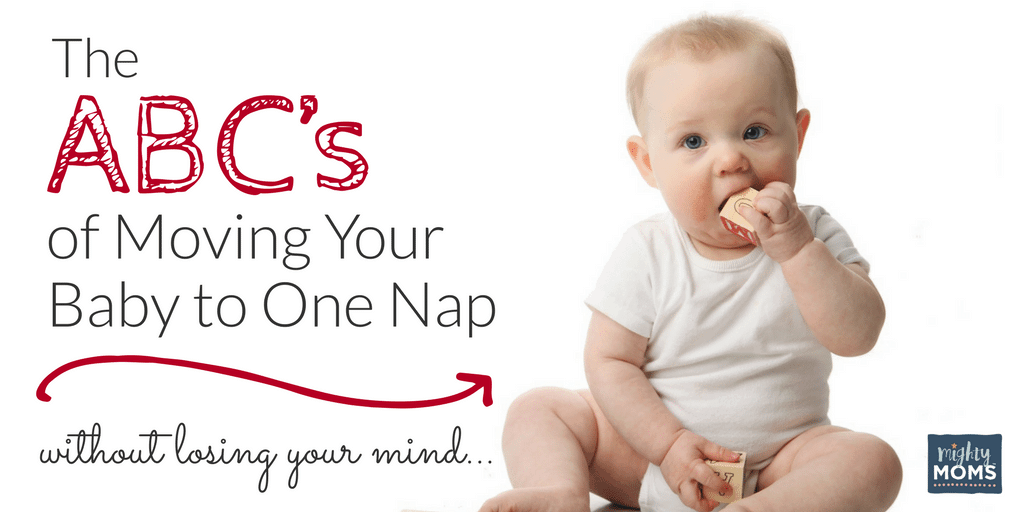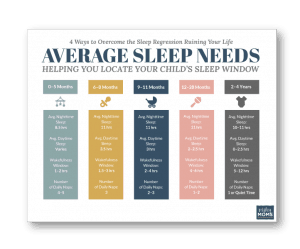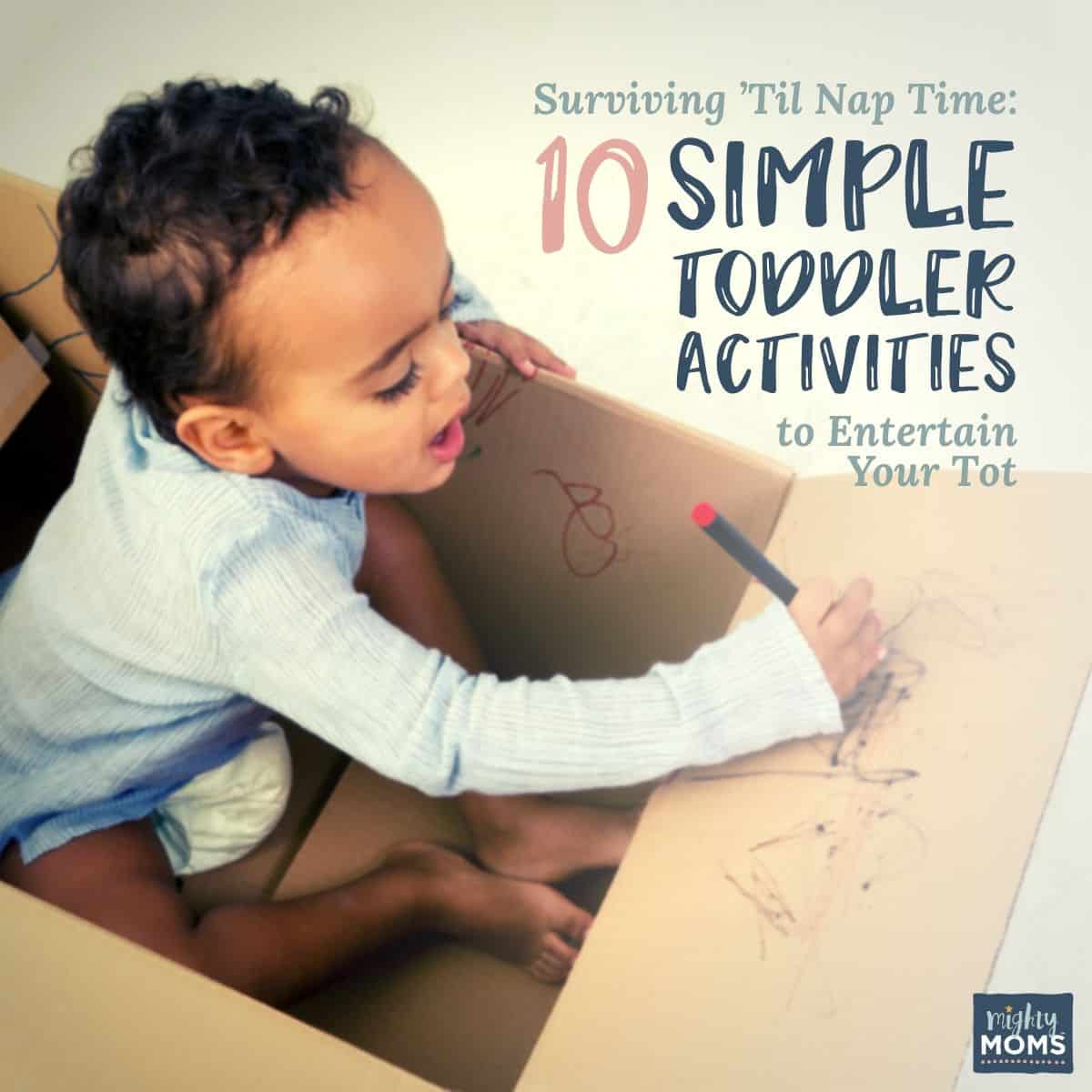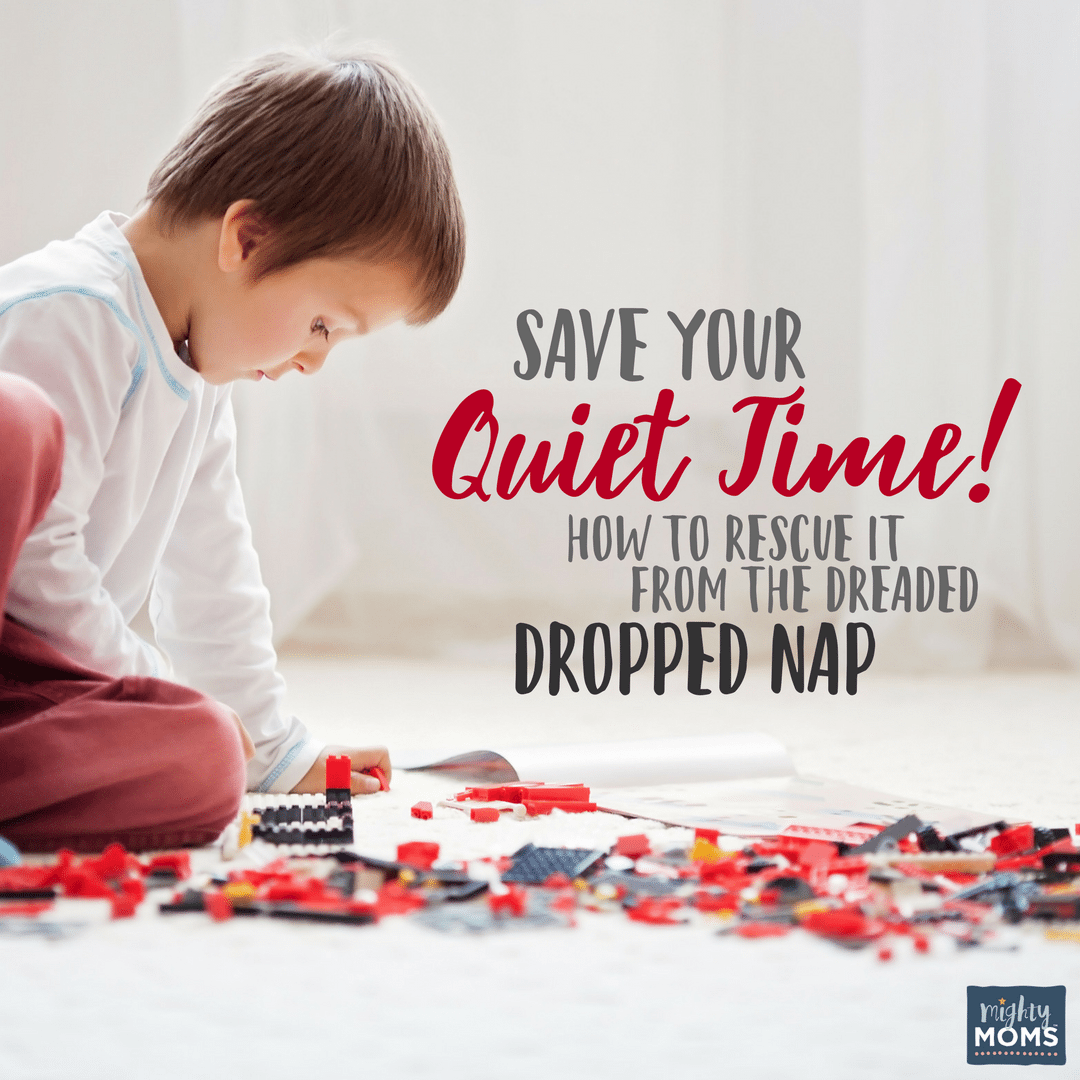
One of the most frequent questions I get, as a Certified Gentle Sleep Coach, is how to tell when it’s time to transition to one nap. What are the signs that you’re ready to go to a one nap schedule?
Usually this question pops up between 15 and 18 months. That’s because this is when your baby starts going through a major developmental shift.
It’s a weird time. Some days he’s a happy bubbly little guy that just doesn’t seem tired for his morning nap – but MY GOODNESS what a monster he becomes around dinner time! Other days, it feels like he’ll fall sleep anywhere.
It’s definitely a Dr. Jekyll and Mr. Hyde kind of situation. In this article, I’ll walk you through the signs your child is ready, and how to make that transition to one nap as easy as possible.

How Do You Know It’s Time
to Transition to One Nap?
As with most sleep coaching, timing is everything.
If you try to move to a one nap schedule and your baby isn’t ready, it will backfire and you’ll be left with an extremely grumpy baby, nighttime wakeups, ulcers, and broken toes (from kicking things in frustration).
Here are the four tests I encourage my clients to use in determining whether or not “it’s time”.
One Nap Test #1: Age Matters.
If your toddler is younger than 15 months, he is not going to be ready for one nap a day.
I’m sure there’s an exception to this rule out there somewhere, but for most of you reading this, heed this warning: Don’t try to make this transition unless he’s passed the other three tests below!
Pushing any sleep coaching when a child isn’t ready is like diving into a pool 10-inches deep. Disaster. You see, when a baby is overtired, his brain stops making the “sleepy happy” hormone melatonin, and starts secreting the “Red Bull for Babies” hormone cortisol instead.
This gives him a second-wind. (Sound familiar? Adults do this too!) This means he’s going to act wired and energized, but his body and brain is really exhausted. The result is more wakeups at night and early wakening (pre-6am).
Pushing a child to a single nap before he’s ready will mean he’s producing more and more cortisol, leading to a lot of crying and wakeups down the road.
If you’re struggling with naps and your baby isn’t ready for this transition to one nap, be encouraged.
I’ve got an online course that will teach you my favorite Nap Coaching Strategies. It’s super cheap and you can watch through the video and fill out the workbook at whatever time is most convenient for you. Click here to see watch my Napping Know-How video.
One Nap Test #2: Consistently Sleeps All Night
If your child is not consistently getting 10-11 hours of uninterrupted sleep at night, then it’s not time to transition to one nap. You can try, yes, but it’s going to be a disaster. (The cortisol thing, remember?)
Instead of moving to a one nap schedule, I would concentrate on helping him get those 10-11 hours of solid sleep at night instead.
Getting your baby to sleep through the night isn’t as daunting as it sounds. We’ve helped hundreds of discouraged parents find success. Sit down with us for an hour and let us help you design a plan that works for your unique baby.
One Nap Test #3: Wonky Morning Naps
Use a sleep log for 4-5 days and see if you notice a greater gap between the time you put him down for his morning nap and when he actually sleeps.
If it’s taking longer and longer for him to fall asleep for that first nap, that’s a good sign that he may be ready to stay awake longer in the morning.
…or you may notice that the morning nap is shorter.
…or you may notice the morning nap is longer, and then he’s refusing to take an afternoon nap.
My point here is that you’re going to need to keep a sleeping log for several days in order to spot these morning patterns. Without seeing these things over a period of several days it will be hard to determine whether or not it’s time to transition.
One Nap Test #4: It Feels Like Groundhog Day
(If you haven’t seen Groundhog Day, you’re totally missing out on A) classic Bill Murray awesomeness and B) my joke. 😥 Get caught up to speed here.)
If your baby is older than 15 months, is sleeping through the night, and seems to be repeating the same wonky napmares every day for 10-14 days, I have a message for you.
*deep breath*
IT’S TIME.
ABC’s of a One Nap Schedule:
“A” is for Adapt Slowly
Think of this process like Celebrity Rehab. You’ll need to move slowly, to avoid a ton of *snapsnapsnap* Diva moments.
First, gradually start to push his morning nap back.
- Days 1 – 2: 11:00am nap
- Day 3 – 4: 11:30am nap
- Day 5 – 6: Noon nap
- Day 6 – 8: 12:30am nap
The goal here is for the afternoon nap to start between 12:30 and 1pm and last around 2 – 2.5 hours. He can sleep longer than 2.5 hours, but don’t let him sleep past 4 or 4:30pm, or it will mess up bedtime.
ABC’s of a One Nap Schedule:
“B” is for Be Flexible
You will want to have a casual approach to the daily schedule, using your Little One’s cues and signals to help you. Try to move bedtime up earlier (maybe closer to 7pm?) while you’re making this transition to one nap, to prevent making him overtired.
You also should be open to having an occasional “two-nap” day. If it’s clear that he’s not going to make it until 12:30 one day, go ahead and put him down for a Quiet Time or nap at around 11. Just limit any morning nap to 45 minutes, max.
ABC’s of a One Nap Schedule:
“C” is for Call for Help (If You Need It)
If your toddler goes down for a nap just fine at 12:30, but wakes after only an hour, you’re going to need to go back in and try to soothe him back to sleep. (He won’t be able to make it to bedtime without hitting the overtired-cortisol wall.)
If you’re not sure how to do this, I would recommend watching my Napping Know-How online class and filling out the provided workbook. The class is super cheap and you can watch at a time that’s convenient to you.
It will go over a variety of sleep strategies for you to choose from, and then help you write up a very specific plan on how to gently coach him back down for a longer nap.
If he’s only going to nap once during the day, it’s important for that nap to be a good one! Otherwise you may find yourself with multiple wake-ups at night, and perhaps a pre-6am wakeup call. *shudder*
Free Sleep Averages Worksheet
Another way to help your child get better naps during the day is to make sure you’re not letting your child stay awake longer than his little brain can handle.
Remember, overtired baby brains switch from making melatonin to making cortisol, making them harder to soothe and more likely to wake prematurely.
Use my free printable below to see what your child’s average “Waketime Window” is. By making sure your child doesn’t stay awake longer than that window, you’ll help ensure you catch the Snoozetrain before it leaves Cortisol Station.

Why is that a direct link and not behind a give-me-your-email wall? Because I don’t want to bully you into a friendship.
If you like the free download, why not subscribe to my weekly email and get a free copy of 101 Ways to Be an Awesome Mom?
Or, if you’re grateful, but not interested in subscribing, can you share this article with your social media pals? That works too!
From one working mother to another, thanks!
Is Your Baby in Daycare?
There are two common questions that pop up usually around this point from parents with children in daycare.
What if daycare insists he takes one nap and he’s not ready?
This is a common issue. The first thing I would suggest is to talk to your provider about possibly moving your baby to a younger age group until he’s ready to move to a single daytime nap.
If that’s not an option, than I would perhaps try to slip in another nap for him at the end of the day, perhaps around 3:30 or 4pm for about 45 minutes. Then put him to bed for good around 8pm. This may totally backfire! You’ll have to test it and see what happens.
Worst case, you can always concentrate on giving him two naps on the weekends, to try to catch up from the week.
What if my child is only in daycare part of the week?
I would try to synchronize the afternoon nap at home with the time they usually put him down at daycare. (Assuming it’s between 12 and 1pm.) This way his internal clock will stay in sync.
An Important Thing to Remember to Make Your Transition to One Nap Easier
This transition to one nap isn’t going to be easy.
Some days will be awesome. You’ll feel like you’re on top of things. She will fall asleep right on time and sleep the full two hours. He will be happy and ready for bed that night.
Some days will not be awesome. She’ll be cranky all day. He’ll wake up at night.
Keep your sleep log. It will help you have a better perspective on what’s a new pattern, and what’s a hiccup.
These days are going to pass, my friend. Small adjustments now will help him ease into a better one nap schedule later. Expect a bumpy road that eventually smooths out, and you’ll be better prepared for the jostling.
Have You Read These Yet?
We ♥ honesty! This post contains affiliate links that provide extra money for our mutual coffee habits addictions. Click here to learn more. As an Amazon Associate I earn from qualifying purchases.
We Love Citations
Toddler Sleep: Is My Toddler Ready to Drop to One Nap? SleepLady.com
How Much Sleep Do Children Need? WebMD.com
No Nonsense Sleeping Guide for Toddlers. WebMD.com



